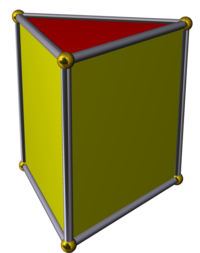Triangular prism
| Triangular prism | |
|---|---|
 | |
| Rank | 3 |
| Type | Uniform |
| Notation | |
| Bowers style acronym | Trip |
| Coxeter diagram | x x3o ( |
| Tapertopic notation | 111 |
| Conway notation | P3 |
| Stewart notation | P3 |
| Elements | |
| Faces | 2 triangles, 3 squares |
| Edges | 3+6 |
| Vertices | 6 |
| Vertex figure | Isosceles triangle, edge lengths 1, √2, √2 |
| Measures (edge length 1) | |
| Circumradius | |
| Volume | |
| Dihedral angles | 4–3: 90° |
| 4–4: 60° | |
| Heights | Trig atop trig: 1 |
| Dyad atop square: | |
| Central density | 1 |
| Number of external pieces | 5 |
| Level of complexity | 3 |
| Related polytopes | |
| Army | Trip |
| Regiment | Trip |
| Dual | Triangular tegum |
| Conjugate | None |
| Abstract & topological properties | |
| Flag count | 36 |
| Euler characteristic | 2 |
| Surface | Sphere |
| Orientable | Yes |
| Genus | 0 |
| Skeleton | GP(3,1) |
| Properties | |
| Symmetry | A2×A1, order 12 |
| Flag orbits | 3 |
| Convex | Yes |
| Net count | 9 |
| Nature | Tame |
The triangular prism, or trip, is a prismatic uniform polyhedron. It consists of 2 triangles and 3 squares. Each vertex joins one triangle and two squares. As the name suggests, it is a prism based on a triangle. Alternatively, it can be seen as the digonal cupola, seen as a dyad atop square.
As an abstract polyhedron, it is the simplest polyhedron that is not self-dual, and the simplest polyhedron with more vertices than faces.
Vertex coordinates[edit | edit source]
A triangular prism of edge length 1 has vertex coordinates given by:
- ,
- .
Representations[edit | edit source]
A triangular prism can be represented by the following Coxeter diagrams:
- x x3o (




 ) (full symmetry)
) (full symmetry) - xx3oo&#x (axial/frustum symmetry only)
- xx ox&#x (A1×A1 axial, generally a wedge)
- ooxx&#xr (A1, vertex first)
- xxx&#x (A1, edge first)
Semi-uniform variant[edit | edit source]
The triangular prism has a semi-uniform variant of the form x y3o that maintains its full symmetry. This variant uses rectangles as its sides.
With base edges of length a and side edges of length b, its circumradius is given by and its volume is given by .
Variations[edit | edit source]
Besides the full symmetric triangular prism, various other polyhedra with 2 triangular and 3 quadrilateral faces exist. the most notable variants are:
- Triangular frustum - 2 base triangles of different sizes, 3 isosceles trapezoids
- Wedge - digonal axial symmetry, 2 isosceles triangles, 1 rectangle, 2 isosceles trapezoids
- Skewed wedge - 2 scalene triangles and 3 different isosceles trapezoids
Other variants with mirror or no symmetry exist.
Related polyhedra[edit | edit source]
A tetrahedron can be attached to a base of the triangular prism to form the elongated triangular pyramid. If both bases have tetrahedra attached, the result is an elongated triangular bipyramid.
It is also possible to augment the square faces of the triangular prism with square pyramids. If this is done to one face the result is the augmented triangular prism. If a second square is augmented the result is the biaugmented triangular prism. If the last remaining square face is also augmented the result is the triaugmented triangular prism.
If two triangular prisms, seen as digonal cupolas, are joined at a square face, such that squares join to triangles, the result is the gyrobifastigium.
A number of non-prismatic uniform polyhedron compounds are composed of triangular prisms:
- Rhomboctahedron (4)
- Disrhomboctahedron (8)
- Chirorhombicosahedron (10)
- Disrhombicosahedron (20)
There are also an infinite amount of prismatic uniform compounds that are the prisms of compounds of triangles.
In vertex figures[edit | edit source]
The triangular prism appears as the vertex figure of the uniform rectified pentachoron. This vertex figure has an edge length of 1.
Variants of the triangular prism by changing the base edge appear as the vertex figure of the uniform rectified icositetrachoron. This vertex figure has an edge length of √2 for the bases. By changing the lateral edges instead, it appears as the vertex figure of the uniform rectified tesseract, with an edge length of √2 for the lateral edges, and the uniform rectified hecatonicosachoron, with an edge length of (1+√5)/2 for the lateral edges, and the rectified great grand stellated hecatonicosachoron with an edge length of (√5-1)/2.
Both edges are changed in the vertex figures of the rectified small stellated hecatonicosachoron, with base edges of length (1+√5)/2 and side edges of length (√5-1)/2 and the rectified great grand hecatonicosachoron, with the edge lengths swapped
External links[edit | edit source]
- Klitzing, Richard. "trip".
- Quickfur. "The Triangular Prism".
- Wikipedia contributors. "Triangular prism".
- McCooey, David. "Triangular Prism"






